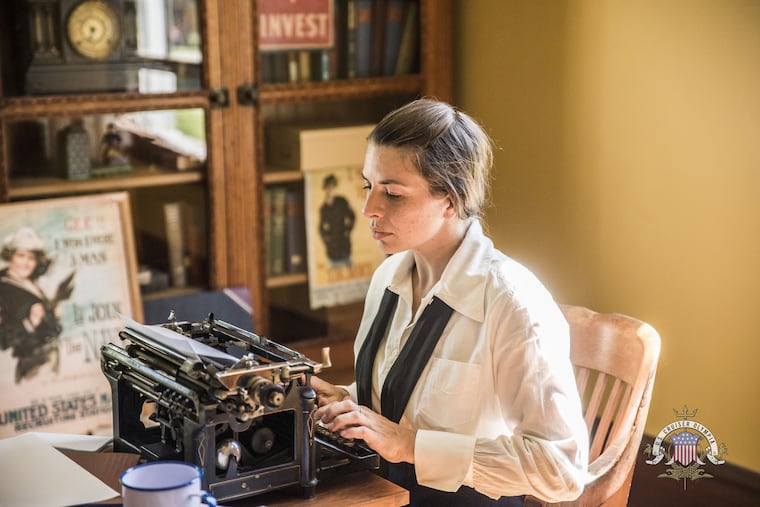She portrays groundbreaking women on the world’s oldest floating steel warship | We The People
"For so long it’s just been such an invisible part of history.”

Meet Laura Adie, a historical reenactor and member of Cruiser Olympia’s Living History Crew.
• Character building: "When you’re wearing the clothes people wore and using the items they used, you get a more visceral connection to the past. I think that’s what the public gets, too. We seem as real as you can get without time-travel.”
• Everyday people: “Seeing how regular, everyday people lived their lives in reaction to the bigger events in the world like wars, elections, and plagues, that’s what interests me.”
The woman in the black-and-white photograph with her hand in a military salute called to Laura Adie from the most unexpected of places — Pinterest.
As Adie scrolled the social media app, the photo struck her in a way she couldn’t shake. She knew the woman’s uniform bore a striking resemblance to sailors’ uniforms from World War I — aside from the skirt and high boots, that is — but Adie couldn’t place her.
“I thought ‘What the heck am I looking at?’” she said.
When Adie dug deeper, what she discovered was the story of groundbreaking women in the military — that of female yeomen, the first enlisted women to serve in the U.S. Navy.
And the first woman of all those women enlisted right here in Philadelphia.
“There wasn’t as much information as I’d love there to be, but there was enough for me to take notice and say, ‘More people should know about this,’” Adie said. “For so long it’s just been such an invisible part of history.”
She was so moved to share the story of these women that in 2016 Adie became the first female member of the Living History Crew with Philadelphia’s Cruiser Olympia, the world’s oldest steel warship still floating. The ship, which is stewarded by the Independence Seaport Museum, is docked at Penn’s Landing.
Adie, a native of Indiana with a master’s degree in historical administration, moved to the Philadelphia region in 2008 for its rich collection of historic sites. Currently, she’s the program and administration manager at Newlin Grist Mill, an 18th century grist mill and park in Glen Mills.
In her downtime, Adie, 39, and her husband, who live in Schwenksville, enjoy swing dancing and World War II reenactments. It was through the reenactment community that Adie heard about the Olympia’s all-volunteer Living History Crew, a group of reenactors who help bring the ship to life for tourists.
When Adie proposed portraying a female yeoman to the Living History Crew and Independence Seaport Museum, they welcomed her aboard.
» MORE WE THE PEOPLE: She went from janitor to vendor at Reading Terminal Market in a year
A yeoman is an enlisted U.S. Navy service member who performs administrative work and clerical tasks. As the title might suggest, yeomen were all men — until 1917.
As the United States headed into World War I that year, it faced a serious manpower shortage. The Navy needed more people to do work stateside, so its sailors could ship off to war. To that end, the secretary of the Navy discovered a loophole that allowed women to enlist in the reserves as yeomen.
The first woman to enlist in the Navy was Loretta Perfectus Walsh, who joined in Philadelphia on March 17, 1917, at the age of 20. Four days later, she was sworn in as chief yeoman, also making her the Navy’s first woman chief petty officer.
“I love to tell people about her,” Adie said. “Perfectus! She has the best name ever.”
Most of the 11,000 women who enlisted as female yeomen served stateside in clerical roles, including at the Philadelphia Navy Yard. They oversaw payrolls, ship assignments, and provisions, among other tasks.
“I think the biggest thing I push is that the Navy would not have been able to function during World War I without these women," Adie said. “A lot of them did it because it was something that needed to be done, but they didn’t necessarily see themselves as huge pioneers.”
» MORE WE THE PEOPLE: What happens when a surrealist decorates a South Philly rowhouse
In fact, stories of their service sometimes never even got passed down to their families.
Adie was in character at Fort Mott, N.J., one day when a man came in and was stunned by her appearance — much like she had been stunned by that photo on Pinterest all those years ago.
“He said ‘I have some photos of my grandmother, I think this might have been what she was,’” Adie recalled. “The next time we were there he came back with photos of her in uniform and said, ‘Now I know what I have.'”
More recently, Adie has also started portraying Frances Benjamin Johnston, a pioneering female photojournalist who photographed Admiral George Dewey aboard the Olympia, and whose photographs are still featured on the Olympia today.
“Everybody who tours the ship today sees these photos she made and doesn’t realize this was a female photographer in the 1890s,” Adie said. “That seemed like an important thing to talk about.”
Want more We the People?
• Joanie Verratti is South Philly’s “wizard of limoncello.”
• Foster dad Micheal Ruff has worked at Lincoln University for 50 years.
• Check out the full We the People archive here.